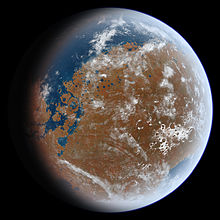
Back المياه على المريخ Arabic مریخده سو وارلیغی AZB Гідрасфера Марса Byelorussian মঙ্গল গ্রহে জল Bengali/Bangla Aigua a Mart Catalan ئاو لەسەر مەریخ CKB Voda na Marsu Czech Νερό στον Άρη Greek Water on Mars English Presencia de agua en Marte Spanish
This article may have too many red links. (August 2024) |

There is less water on Mars compared to Earth. Most of the water known is in the cryosphere (permafrost and polar caps). There is no liquid water. There is only a small amount of water vapor in the thin atmosphere.[1]
The conditions on the planet's surface do not support the long-term existence of liquid water. The average atmospheric pressure and temperature are far too low, which freezes water. However, it seems Mars once had liquid water flowing on the surface.[2][3] This would make large areas like Earth's oceans.[4][5][6][7]
There are a number of signs of water on or under the surface, now or in the distant past.[8] These include stream beds, polar caps, spectroscopic measurement, eroded craters. Also, there are minerals which are often formed when there is liquid water (such as goethite), grey, crystalline hematite, phyllosilicates, opal, and sulfate.[9][10][11][12][13]
The Mars flybys such as Viking, Mars Odyssey, Mars Global Surveyor, Mars Express, and the Mars Reconnaissance Orbiter had cameras. They took pictures of what seem to be ancient lakes, ancient river valleys, and widespread glaciation.[14][15][16][17][18] An orbiting Gamma Ray Spectrometer found ice just under the surface of much of the planet. Also, radar studies found ice that were thought to be glaciers. The Phoenix lander showed ice on Mars when it was landing. Phoenix also showed ice melting, snow falling, and even saw drops of liquid water.[19][20][21]
A recent report says Martian dark streaks on the surface were affected by water.[22]
- ↑ "Mars Global Surveyor measures water clouds". Archived from the original on August 12, 2009. Retrieved March 7, 2009.
- ↑ "Flashback: water on Mars announced 10 Years Ago". SPACE.com. June 22, 2000. Retrieved December 19, 2010.
- ↑ "Science@NASA, The Case of the Missing Mars Water". Archived from the original on March 26, 2010. Retrieved March 7, 2009.
- ↑ Morton, Oliver (4 October 2002). Mapping Mars: Science, Imagination, and the Birth of a World. Picador. ISBN 0-312-24551-3.
- ↑ "PSRD: Ancient Floodwaters and Seas on Mars". Psrd.hawaii.edu. July 16, 2003. Retrieved December 19, 2010.
- ↑ "Gamma-Ray Evidence Suggests Ancient Mars Had Oceans | SpaceRef – Your Space Reference". SpaceRef. November 17, 2008. Retrieved December 19, 2010.
- ↑ Carr, M.; Head, J. (2003). "Oceans on Mars: An assessment of the observational evidence and possible fate". Journal of Geophysical Research. 108 (E5): 5042. Bibcode:2003JGRE..108.5042C. doi:10.1029/2002JE001963.
- ↑ "Water at Martian south pole". March 17, 2004. Retrieved September 29, 2009.
- ↑ "ch4". History.nasa.gov. Retrieved December 19, 2010.
- ↑ Harrison, K; Grimm, R. (2005). "Groundwater-controlled valley networks and the decline of surface runoff on early Mars". Journal of Geophysical Research. 110 (E12). Bibcode:2005JGRE..11012S16H. doi:10.1029/2005JE002455.
- ↑ Howard, A.; Moore, Jeffrey M.; Irwin, Rossman P. (2005). "An intense terminal epoch of widespread fluvial activity on early Mars: 1. Valley network incision and associated deposits". Journal of Geophysical Research. 110 (E12). Bibcode:2005JGRE..11012S14H. doi:10.1029/2005JE002459.
- ↑ "Articles | Was there life on Mars? – ITV News". Itv.com. Archived from the original on June 6, 2011. Retrieved December 19, 2010.
- ↑ Glotch, T. and P. Christensen. 2005. Geologic and mineralogical mapping of Aram Chaos: Evidence for water-rich history. J. Geophys. Res. 110. doi:10.1029/2004JE002389
- ↑ Fassett, C.; Head, III (2008). "Valley network-fed, open-basin lakes on Mars: Distribution and implications for Noachian surface and subsurface hydrology". Icarus. 198 (1): 37–56. Bibcode:2008Icar..198...37F. doi:10.1016/j.icarus.2008.06.016.
- ↑ Parker, T.; Clifford, S. M.; Banerdt, W. B. (2000). "Argyre Planitia and the Mars Global Hydrologic Cycle" (PDF). Lunar and Planetary Science. XXXI: 2033. Bibcode:2000LPI....31.2033P.
- ↑ Heisinger, H.; Head, J. (2002). "Topography and morphology of the Argyre basin, Mars: implications for its geologic and hydrologic history". Planet. Space Sci. 50 (10–11): 939–981. Bibcode:2002P&SS...50..939H. doi:10.1016/S0032-0633(02)00054-5.
- ↑ Moore, J.; Wilhelms, D. (2001). "Hellas as a possible site of ancient ice-covered lakes on Mars". Icarus. 154 (2): 258–276. Bibcode:2001Icar..154..258M. doi:10.1006/icar.2001.6736. hdl:2060/20020050249. S2CID 122991710.
- ↑ Weitz, C.; Parker, T. (2000). "New evidence that the Valles Marineris interior deposits formed in standing bodies of water" (PDF). Lunar and Planetary Science. XXXI: 1693. Bibcode:2000LPI....31.1693W.
- ↑ "Liquid Saltwater Is Likely Present On Mars, New Analysis Shows". Sciencedaily.com. 2009-03-20. Retrieved 2011-08-20.
- ↑ Kessler, Andrew (15 April 2011). Martian Summer. Pegasus Books. ISBN 978-1-60598-176-5.
- ↑ Rennó, Nilton O.; Bos, Brent J.; Catling, David; Clark, Benton C.; Drube, Line; Fisher, David; Goetz, Walter; Hviid, Stubbe F.; Keller, Horst Uwe (2009). "Possible physical and thermodynamical evidence for liquid water at the Phoenix landing site". Journal of Geophysical Research. 114 (E1). Bibcode:2009JGRE..114.0E03R. doi:10.1029/2009JE003362. hdl:2027.42/95444.
- ↑ Amos, Jonathan 2015. Martian salt streaks 'painted by liquid water'. BBC News Science & Environment. [1]